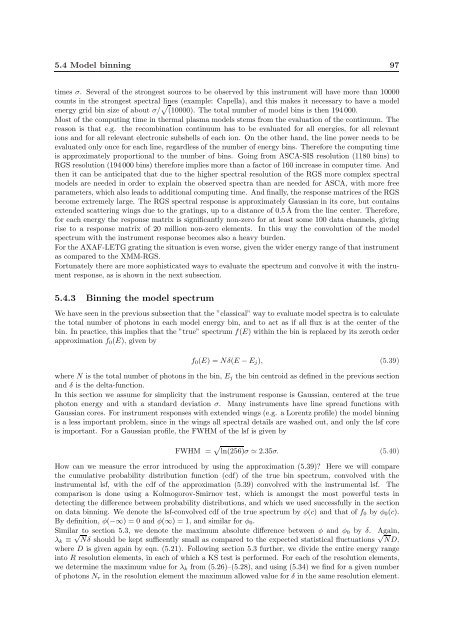SPEX User's Manual - SRON
SPEX User's Manual - SRON
SPEX User's Manual - SRON
Create successful ePaper yourself
Turn your PDF publications into a flip-book with our unique Google optimized e-Paper software.
5.4 Model binning 97<br />
times σ. Several of the strongest sources to be observed by this instrument will have more than 10000<br />
counts in the strongest spectral lines (example: Capella), and this makes it necessary to have a model<br />
energy grid bin size of about σ/ √ (10000). The total number of model bins is then 194000.<br />
Most of the computing time in thermal plasma models stems from the evaluation of the continuum. The<br />
reason is that e.g. the recombination continuum has to be evaluated for all energies, for all relevant<br />
ions and for all relevant electronic subshells of each ion. On the other hand, the line power needs to be<br />
evaluated only once for each line, regardless of the number of energy bins. Therefore the computing time<br />
is approximately proportional to the number of bins. Going from ASCA-SIS resolution (1180 bins) to<br />
RGS resolution (194000 bins) therefore implies more than a factor of 160 increase in computer time. And<br />
then it can be anticipated that due to the higher spectral resolution of the RGS more complex spectral<br />
models are needed in order to explain the observed spectra than are needed for ASCA, with more free<br />
parameters, which also leads to additional computing time. And finally, the response matrices of the RGS<br />
become extremely large. The RGS spectral response is approximately Gaussian in its core, but contains<br />
extended scattering wings due to the gratings, up to a distance of 0.5Å from the line center. Therefore,<br />
for each energy the response matrix is significantly non-zero for at least some 100 data channels, giving<br />
rise to a response matrix of 20 million non-zero elements. In this way the convolution of the model<br />
spectrum with the instrument response becomes also a heavy burden.<br />
For the AXAF-LETG grating the situation is even worse, given the wider energy range of that instrument<br />
as compared to the XMM-RGS.<br />
Fortunately there are more sophisticated ways to evaluate the spectrum and convolve it with the instrument<br />
response, as is shown in the next subsection.<br />
5.4.3 Binning the model spectrum<br />
We have seen in the previous subsection that the ”classical” way to evaluate model spectra is to calculate<br />
the total number of photons in each model energy bin, and to act as if all flux is at the center of the<br />
bin. In practice, this implies that the ”true” spectrum f(E) within the bin is replaced by its zeroth order<br />
approximation f 0 (E), given by<br />
f 0 (E) = Nδ(E − E j ), (5.39)<br />
where N is the total number of photons in the bin, E j the bin centroid as defined in the previous section<br />
and δ is the delta-function.<br />
In this section we assume for simplicity that the instrument response is Gaussian, centered at the true<br />
photon energy and with a standard deviation σ. Many instruments have line spread functions with<br />
Gaussian cores. For instrument responses with extended wings (e.g. a Lorentz profile) the model binning<br />
is a less important problem, since in the wings all spectral details are washed out, and only the lsf core<br />
is important. For a Gaussian profile, the FWHM of the lsf is given by<br />
FWHM = √ ln(256)σ ≃ 2.35σ. (5.40)<br />
How can we measure the error introduced by using the approximation (5.39)? Here we will compare<br />
the cumulative probability distribution function (cdf) of the true bin spectrum, convolved with the<br />
instrumental lsf, with the cdf of the approximation (5.39) convolved with the instrumental lsf. The<br />
comparison is done using a Kolmogorov-Smirnov test, which is amongst the most powerful tests in<br />
detecting the difference between probability distributions, and which we used successfully in the section<br />
on data binning. We denote the lsf-convolved cdf of the true spectrum by φ(c) and that of f 0 by φ 0 (c).<br />
By definition, φ(−∞) = 0 and φ(∞) = 1, and similar for φ 0 .<br />
Similar to section 5.3, we denote the maximum absolute difference between φ and φ 0 by δ. Again,<br />
λ k ≡ √ Nδ should be kept sufficently small as compared to the expected statistical fluctuations √ ND,<br />
where D is given again by eqn. (5.21). Following section 5.3 further, we divide the entire energy range<br />
into R resolution elements, in each of which a KS test is performed. For each of the resolution elements,<br />
we determine the maximum value for λ k from (5.26)–(5.28), and using (5.34) we find for a given number<br />
of photons N r in the resolution element the maximum allowed value for δ in the same resolution element.

















